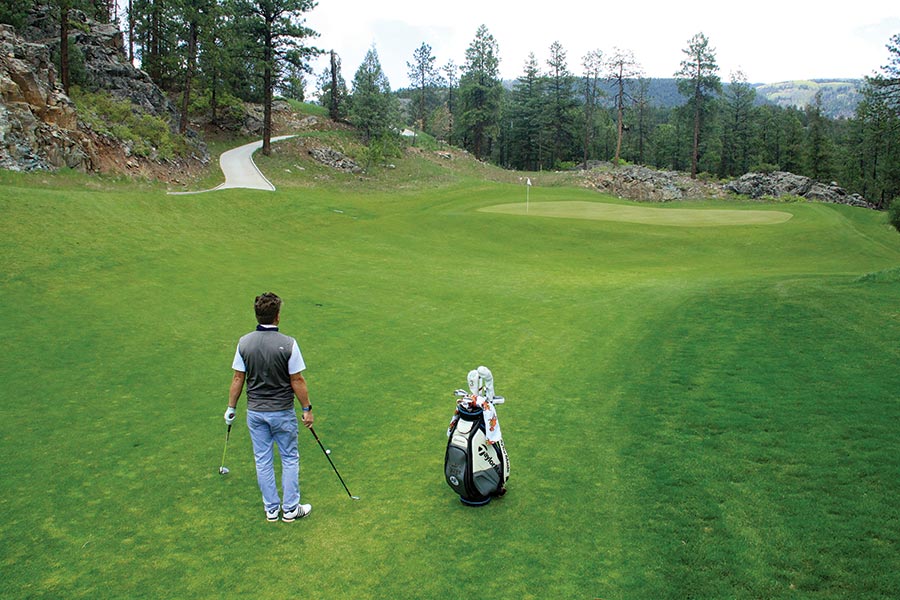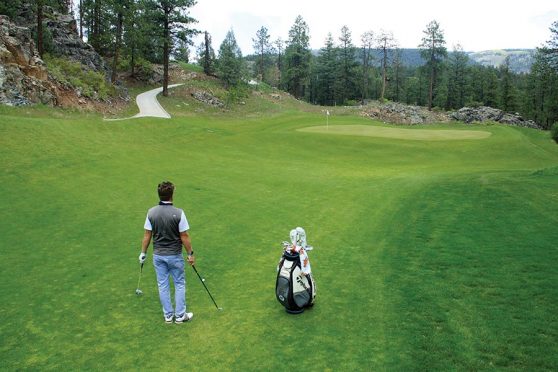PHOTOS: Colorado’s Drive, Chip and Putt Champs
Three Colorado kids took on the world at the 2024 Drive, Chip and Putt Championship at Augusta National

By Alex Fisher
WHEN YOU’RE 100 YARDS OUT, do you automatically reach for one of your wedges? If so, you’re not alone. Most golfers I see tend to defer to one type of shot when facing this situation—a high, cool-looking shot into the green. But if you do not have to fly a bunker or hazard and you have a clear path to the green, why not consider hitting a lower-flighted shot instead?
In any short-shot situation, take the path of least resistance. If you can get away with using a less-lofted club and making a smaller swing, the mistakes tend to result in fewer wasted strokes. Yes, that parachute shot looks awesome when you pull it off, but the margin of error is minuscule because of the size and speed of the swing required to execute it.
Before you decide which shot to attempt, first consider the quality of the lie.
If you are fortunate enough to find yourself in a situation where the ball is sitting up, your options dramatically improve. You can get away with a slight mishit because the ball is sitting up. However, if the ball is sitting down—a tight lie—your options become very limited. The less grass underneath the ball, the smaller your margin for error and the greater your need to make more precise contact. That can lead to a lack of confidence because often you hit the ground behind the ball or even miss the ground altogether.
Another often-overlooked consideration is how you can use the terrain that is between you and target to your advantage. For example, if you have a pin at the front of the green and your landing space is very limited, it might be easier to hit a low-flighted shot into the bank in front of the green and rolling it on than trying to fly the ball to a front flag position.

MOMENT OF DECISION
• Once you’ve evaluated the lie to determine the type of shot you can hit, factor in what is between you and the flag and how you can use the terrain to your advantage.
• Try to visualize the shot you want to hit—its trajectory and distance.
• Focus less on the flag and more on the landing spot—always your primary target.
GOING GROUND
1. A CHIP OFF THE OLD HYBRID
• If you decide to scoot the ball up to the green, you are basically hitting a chip with a longer club.
2. ALL ARMS, NO BODY
• Limit your backswing by taking the club back with your arms only.
• Make sure your chest does not rotate away from the ball so that your weight does not move to your back foot. Any weight shift will make it difficult to avoid hitting the ground behind the ball because the swing motion is so small.
3. BACKSWING = FOLLOW-THROUGH
•As the club approaches the ball, your chest should have rotated past the ball before the arms and hands deliver the club. This will allow you to not let the club outrace the body and avoid the wrists from flipping at impact.
•Make sure your follow-through finishes at the same length as your backswing. This will help you maintain a consistent tempo throughout the swing and avoid overshooting your target.
AERIAL ATTACK
1. HIGH-MINDED THOUGHTS
2. LEVERAGE FOR LOFT
• Allow your hands and arms to initiate the back- swing before any body rotation occurs. The amount of body rotation the swing will require is dependent on the distance you need to hit the ball.
• Fully hinge your wrists before your lead arm is halfway back and parallel to the ground.
• Avoid over-rotating on the backswing, which makes it difficult to transfer your weight on the downswing and make solid contact with the ball.
3. STICK IT TO SPIN IT
• Initiate the downswing by allowing your body to rotate towards the ball first. It is vital that your arms and hands do not outrace your body as it will cause the club to bottom out earlier and either hit the ground before the ball or miss the ground altogether.
• Keep an even tempo. On shorter pitch shots, accelerating through the ball too quickly makes it hard to control your distances and possibly hit the ball twice.
4. FINISH HIGH
• Again, make sure your follow-through length equals that of your backswing.
This article was also featured in the August/September 2021 Issue of Colorado AvidGolfer.
Colorado AvidGolfer is the state’s leading resource for golf and the lifestyle that surrounds it, publishing eight issues annually and proudly delivering daily content via coloradoavidgolfer.com.
Three Colorado kids took on the world at the 2024 Drive, Chip and Putt Championship at Augusta National
Scotland’s Old Course, North Berwick, Carnoustie and other greats are accessible with planning, luck and a spirit of adventure
The Colorado private-club solar system is about to see a giant new planet come into orbit
Boy Scout turns to golf to help honor the Greatest Generation